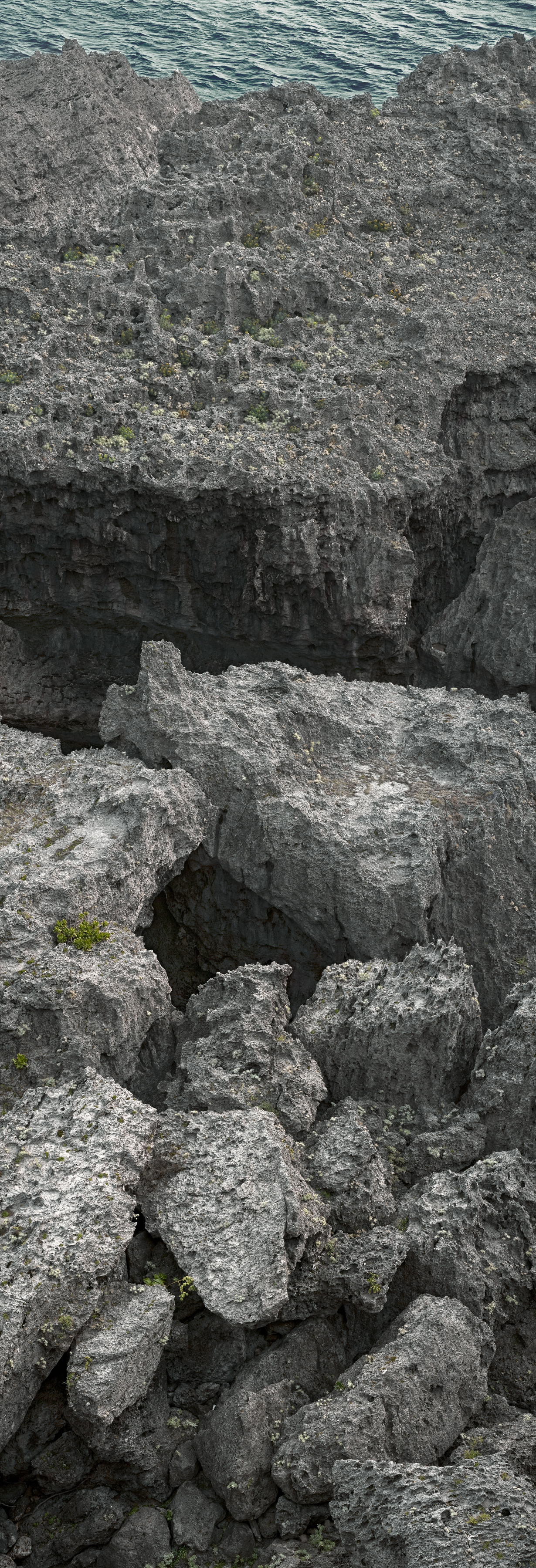September 20, 2008
The Coleman Center for the Arts is pleased to present a new exhibition by renowned artist, Osamu James Nakagawa. The exhibition will be open from August 15 to September 29, and a closing reception will be held on September 20th from 6 to 8 PM.
In Okinawan the word banta means cliffs. These Okinawan cliffs are the subject of Nakagawa’s new series, which depicts the historically significant and visually astonishing landscape, known for the tragic battles of the second world war. Nakagawa recalls, “ For years I have carried with me a vivid memory of the first time I stood atop these cliffs—a memory of beauty in the endless blue expanse of sea and sky intensified by the fearsome height and history that met my downward gaze.”
Much of Nakagawa’s work explores his dual heritage as a Japanese and an American. His images often strive to define an “in between” place, that is bound by emotion, history, family, life, and death. The Banta series extends these ideas. Okinawa has a long history of being politically situated between powerful opposing forces. Nakawgawa’s images call to mind stories of Okinawan civilians, caught in the midst of the battle between American and Japanese troops and subject to war propaganda, who took their lives on the cliffs.
The post-war history of Okinawa has left the island situated between America and Japan. For over 25 years the island was controlled by the United States. In 1972 it was returned to Japan, but Okinawa is still home to 75 percent of U.S. military bases in Japan. In the artist words, the cliffs “become a metaphor for Okinawa’s history as well as a digitally-manipulated, hyper-real vision of my experience standing between fear and beauty on Okinawa’s banta.” .
The hyper-reality of the images has an eerie quality. Aesthetically, they may reference the sharply focussed and highly detailed images of photography’s past. But Nakagawa’s digitally manipulated images are laden with a heavy historical and emotional weight. The intense detail brings an unreal clarity to the images, demanding a heightened sense of visual and emotional awareness. A meditation on the effects of war, Nakagawa is able to express an historical tragedy through extreme beauty.
This exhibition was made possible by support from the Japan Foundation, New York, the Alabama State Council on the Arts, the National Endowment for the Arts, and the generous contributions of our individual supporters. For more information please contact the Coleman Center for the Arts, at 205-392-2005, or email colemancenter@gmail.com.
About the Artist
Osamu James Nakagawa was born in New York City; raised in Tokyo, Japan and returned to Houston, Texas at the age of 15. He received a Bachelor of Arts from the University of St. Thomas Houston in 1986 and a Master of Fine Arts from the University of Houston in 1993. Currently, Nakagawa is an associate professor and the head of photography department at Indiana University.
Nakagawa’s work is shown internationally. His solo exhibitions include, Course, Banta: Osamu James Nakagawa, SEPIA International, New York, NY; Ma-between the past, McMurtrey Gallery, Houston, Texas; Kai: Osamu James Nakagawa, SEPIA International, New York, NY, Mado, Houston Center for Photography. Selected group shows include Traces and Omens, 2005 Noorderlicht Photofestival, Groningen, Netherlands, Contemporary American Photography, 7 International Fototage 2005, Mannheim Germany; Common Ground, Corcoran Museum of Fine Arts, Washington D.C.; Cuenca, Ecuador Bienal ’98: Borderline Figuration; Medialogue-Photography in Contemporary Japanese Art ’98, Tokyo Metropolitan Museum of Photography; Field of Vision: Five Gulf Coast Photographers, Contemporary Arts Museum, Houston. His work has been published and reviewed in Art News, New York Times, New Yorker Magazine, Time Magazine; Village Voice, Aperture: Metamorphoses, Edition Stemmle: Waterproof, Enfoco: Nueva Luz, and others. Nakagawa received grants and fellowship from the Santa Fe Center for Visual Arts; Indiana Arts Commission; The Light Work, Syracuse, NY; The Anderson Ranch Arts Center, Co.; Houston Center for Photography; the American Photography Institute, New York City; Cultural Arts of Houston/Harris County. His work is in the permanent collections of the Metropolitan Museum of Art, International Museum of Photography at George Eastman House; Tokyo Metropolitan Museum of Photography; Kiyosato Museum of Photographic Arts, Japan; Museum of Fine Arts, Houston; The Museum of Contemporary Photography Chicago and others.

